My initial shock and dismay over the vast destruction laid to my Cinnamon Sun sunflowers and Zexmenia by millions and gazillions of caterpillars all at one time were fortunately temporary emotions, and I’ve adjusted to this new level of habitat. I’m back to feeling happy, content, and utterly pleased. The butterflies fluttering about the garden today are more numerous than I’d ever dreamed of (I’m still astounded by this, I admit), and they swept me up in waves of joy and peace. Soon, all those hundreds of ravenous Bordered Patch caterpillars that caused me momentary freak-out will create an even more amazing butterfly scene — who can argue with that?
So I won’t dwell on the skeleton leaves and plant carcasses they are leaving behind and I will instead rejoice in the fact that most of the plants so far are surviving and putting on a beautiful bloom display — 30 blooms almost entirely on one Cinnamon Sun plant alone. I get to report on new butterflies in the garden, as well, and also bees and spiders, and this habitat mama is happy as a clam.
If ever there was a question about sunflowers being so aptly named, I present this photo as a clear argument for the appropriateness. It shows the fiery side of the sun in flower form. In fact, I almost named this post Sunrise or Sunset after this shot, because that’s what it makes me think of, but I actually took this in the middle of the day, so it would be cheating.
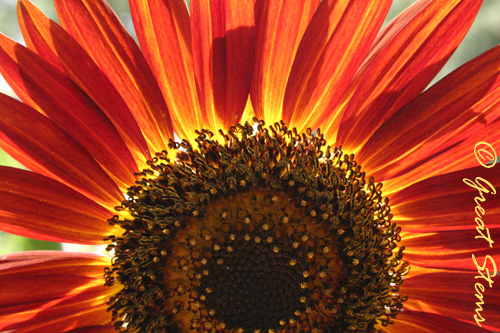
As I hovered around my sunflowers, alternating between pictures of blooms and caterpillar damage, I was joined by hummingbirds just a few feet away at the Standing Cypress, flying closer to me than ever and completely ignoring me. I missed the snapshot, though, because the two hummingbirds suddenly had one of their feisty spats and flew off. I’m not sure they even realized how close to me they were.
And then I saw the bees at the sunflowers, and my attention turned back to the fiery blazes before me. These weren’t honeybees — they were “Yellow Butt Bees” as I called them when I first saw them (Please don’t think that’s their real name! I was just distinguishing them from the similarly-sized honeybees we all know. Besides, perhaps “Yellow Belly” would be more appropriate; I can hear Yosemite Sam now calling them Yellow-bellied Varmints… except they are no varmints!). The best I could do was try to get some pictures in the poor light so that I could ID them later. I believe they are the species Megachile perihirta. Western Leafcutter Bees. Texas natives, woot.
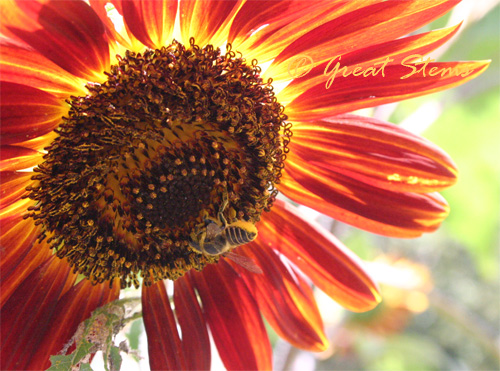
Why are they called Leafcutter Bees? Well, they cut small little circles out of leaves and use the pieces to fashion little nest cells, adding to them some nectar and pollen for the eggs they’ll lay. These solitary bees are some of the bees that benefit from Bee Boxes.
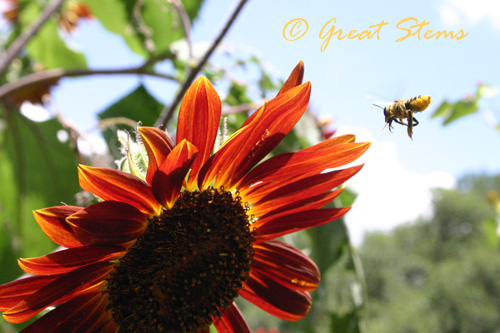 At one point, one of the bees looked straight at me. The little bee looks so cute that it seems unreal — my son actually thought I stuck the bee image onto the photo. I like to think that it was posing for the camera and not considering me a momentary threat. In any case, it was cute enough to become a header shot for the blog page (scroll up and click refresh if you’d like to see it).
At one point, one of the bees looked straight at me. The little bee looks so cute that it seems unreal — my son actually thought I stuck the bee image onto the photo. I like to think that it was posing for the camera and not considering me a momentary threat. In any case, it was cute enough to become a header shot for the blog page (scroll up and click refresh if you’d like to see it).
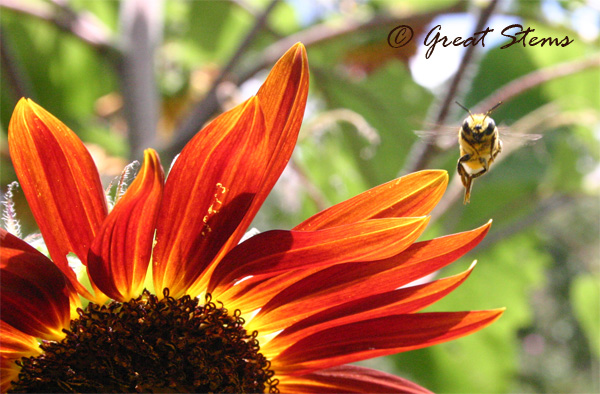
At the same time as their larger cousins, tinier native bees were also busy at work. They are harder to see, crawling in and out of the little flower parts.
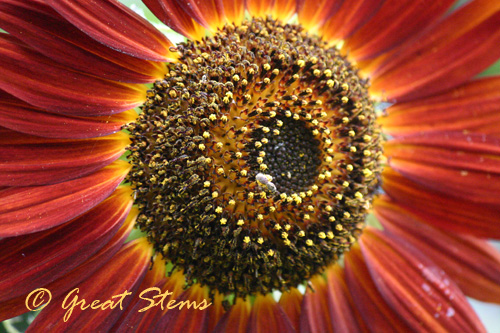
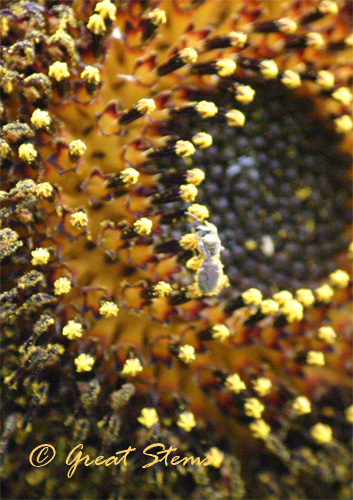 These native bees are the best pollinators a garden could ask for. Hugs to them all.
These native bees are the best pollinators a garden could ask for. Hugs to them all.
Back at the Gregg’s Mistflower in the Spider’s Favorite Locale, a spider reigns queen predator. I believe she is a Banded Garden Spider, Argiope trifasciata. And I think she might be the very same spider I found in the same spot a couple of weeks ago, perhaps then a juvenile and now mature (I’ve edited that post). She’s a beauty, and highly successful in her predator talents. She had four wrapped-up carcasses that she was very focused on, and within hours she had consumed them, removed them, and repaired the web, ready for more.
She’s as beautiful on her upper exterior…
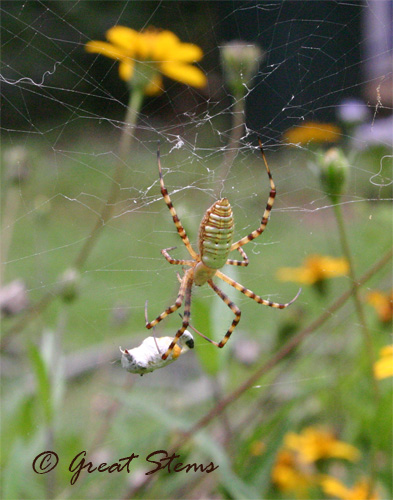 as she is underneath. In fact, I shot the picture below first before I even realized she was facing away from me.
as she is underneath. In fact, I shot the picture below first before I even realized she was facing away from me.
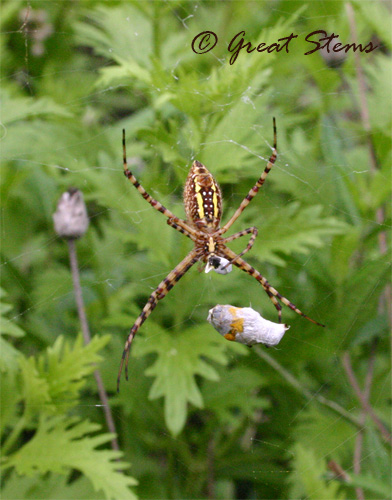 I spy what might be pollen seeping through the silk encasing — might that be another bee? Gah. The nature of nature, once again.
I spy what might be pollen seeping through the silk encasing — might that be another bee? Gah. The nature of nature, once again.
To follow up on the Bordered Patch butterflies, I’m happy to report that they do eat Straggler Daisy, or Horseherb. In fact, there are already other groups of them out there munching away. The ones in the picture below are a little too small for me to identify for sure as Bordered Patch, but they are surely related, at the very least.
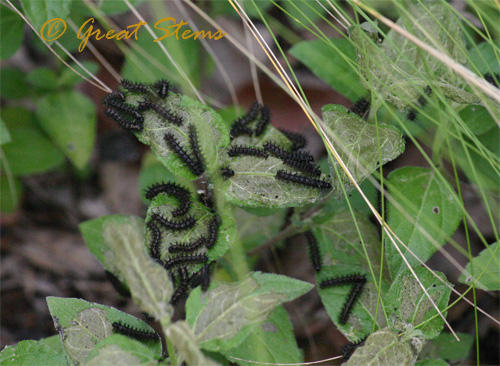 I took a few of the more severely devasted sunflower leaves still covered with tons of caterpillars and relocated the little crawlies to the Horseherb for a dietary change, and so far so good. There are still many dozens on the sunflowers, but I feel better about all the plants’ chances at this point. And as I mentioned last time, I’ve got plenty of Horseherb to go around. I also discovered even more groups of young caterpillars on the Zexmenia, but those plants are fairly well established and are thus on their own. I read that one Bordered Patch female can lay 500 eggs — now I understand why I have such an invasion of munching munchers.
I took a few of the more severely devasted sunflower leaves still covered with tons of caterpillars and relocated the little crawlies to the Horseherb for a dietary change, and so far so good. There are still many dozens on the sunflowers, but I feel better about all the plants’ chances at this point. And as I mentioned last time, I’ve got plenty of Horseherb to go around. I also discovered even more groups of young caterpillars on the Zexmenia, but those plants are fairly well established and are thus on their own. I read that one Bordered Patch female can lay 500 eggs — now I understand why I have such an invasion of munching munchers.
The older caterpillars are looking quite interesting, now that they are getting large.
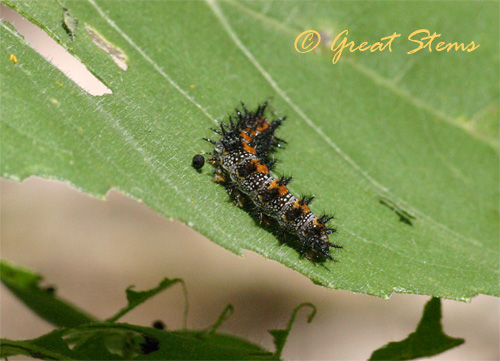 Hmmm. Another caterpillar discovery. I have Genista moth caterpillars munching on one of my Texas Mountain Laurels, and eggs on another. But from what I read, the laurels should be okay. There are so many mountain laurels here in Austin, Texas, and they all do okay, right? The damage is ugly, though, but not devastating. I think. Hmmm, I feel the inkling of worry again…
Hmmm. Another caterpillar discovery. I have Genista moth caterpillars munching on one of my Texas Mountain Laurels, and eggs on another. But from what I read, the laurels should be okay. There are so many mountain laurels here in Austin, Texas, and they all do okay, right? The damage is ugly, though, but not devastating. I think. Hmmm, I feel the inkling of worry again…
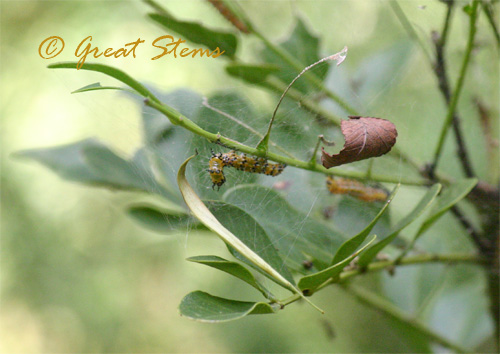
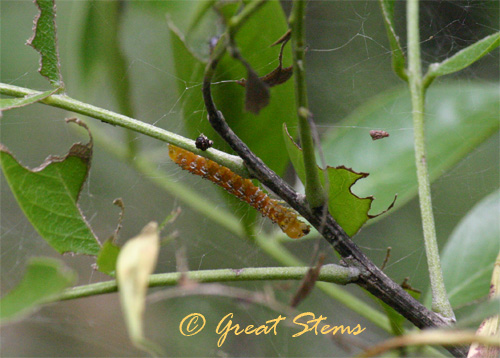 I’m not sure whether these are Genista eggs, but I suspect they could be.
I’m not sure whether these are Genista eggs, but I suspect they could be.
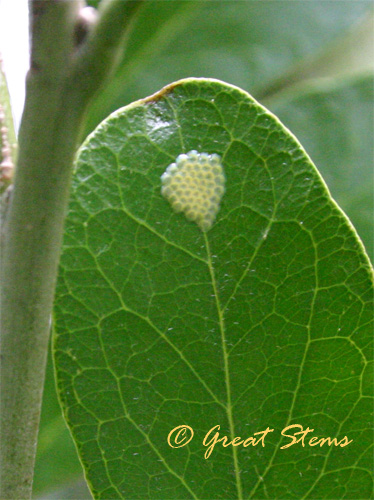 While I was walking around outside, something large moving by caught my eye. At first I thought it was a bird, but then I realized it was a butterfly. From a distance I couldn’t tell whether it was a Giant Swallowtail or an Eastern Tiger, but it was definitely huge. And then it came down right by me for a nectar feast on the butterfly bush. An Eastern Tiger Swallowtail. Yay!
While I was walking around outside, something large moving by caught my eye. At first I thought it was a bird, but then I realized it was a butterfly. From a distance I couldn’t tell whether it was a Giant Swallowtail or an Eastern Tiger, but it was definitely huge. And then it came down right by me for a nectar feast on the butterfly bush. An Eastern Tiger Swallowtail. Yay!
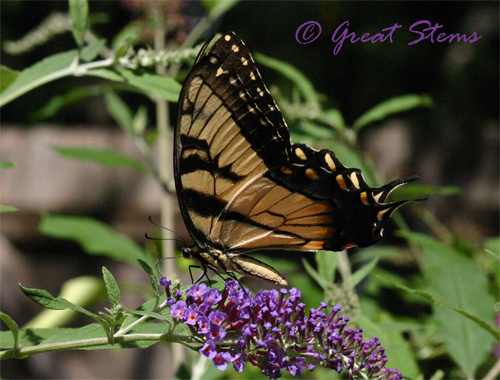
It’s the first time one has stayed still long enough for me to get a non-blurry picture. The sun was too harsh, but I’ll take what I can get. I continue to have a wary eye on the butterfly bush (Buddleia davidii, a non-native with a questionable reputation), but it earned big points when that Eastern Tiger landed upon it.
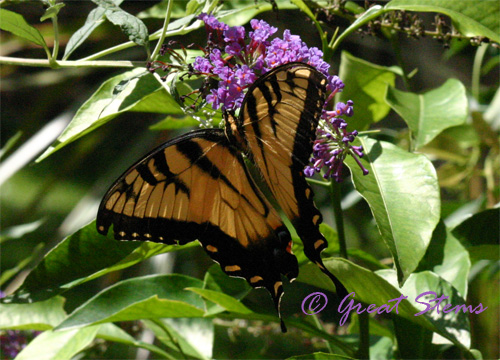 I’m still waiting on my Giants to emerge from their chrysalises. I’m getting nervous, as I always do.
I’m still waiting on my Giants to emerge from their chrysalises. I’m getting nervous, as I always do.
Buckeyes are here now! New visitors to the garden. So beautiful.
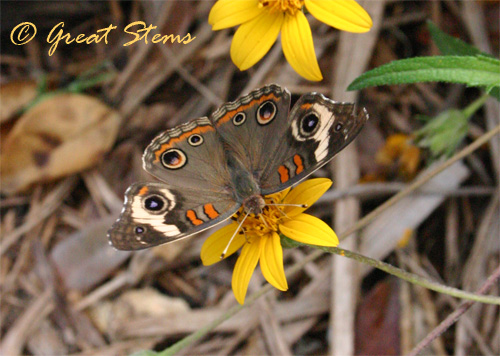 And I still can’t resist the charm of the Cinnamon Sun sunflowers. More pictures must be posted.
And I still can’t resist the charm of the Cinnamon Sun sunflowers. More pictures must be posted.
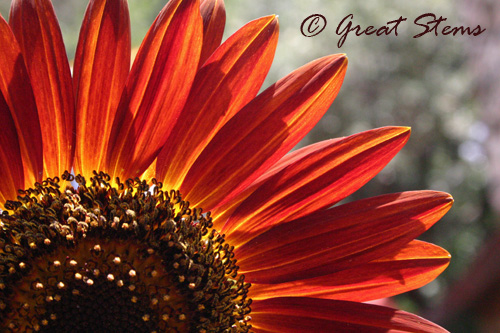
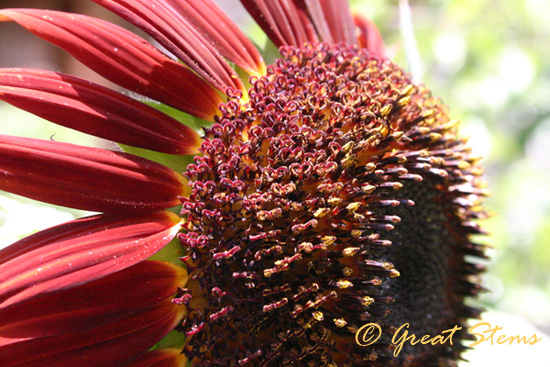
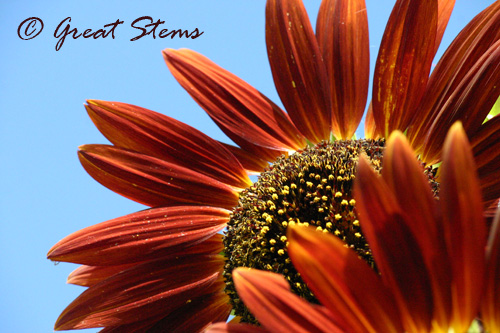 See what I mean?
See what I mean?
So many great shots! The sunflower, the bee, the spider, the tiger…but I think I like Buckeye the best. Really shows its beautiful colored patterns and spots.
Beautiful photos again. My favorite is the leafcutter bee with his little feet together.
To me, your sunflowers look more like solar eclipse coronas than either sunrises or sunsets.
http://www.jplnet.com/03eclipse/03eclipse-corona1000.jpg
Wow! Your photos are fantastic.
Great photos. I always learn something, when I drop by your blog.
Thanks….
I understand your mixed emotions re. the cats and their devestation. I’ve gone through it also, horrified at the damage the gulf fratillary cat did to my passion vine. Once I came to terms with the butterfly cycle, I purchased milkweed specifically for the monarchs. I no longer have pretty flowers to photo, but bare stems. Regardless, they are serving their purpose, which I’m excited for!
I like your info re. the bees. I didn’t know about the little leaf cutter bee until last year when one kept trying to nest in the tube of my pool fountain. Poor little thing’s nest got blasted every time the fountain turned on. He’s since taken up residence in a little shell. I have yet to build a bee box, but it’s on my list.
Your sunflowers are absolutely breathtaking! Love the color!